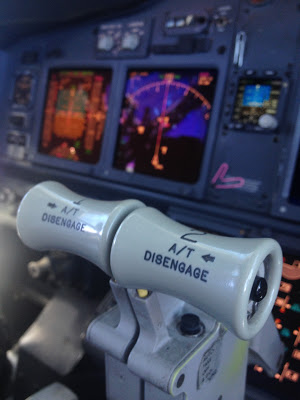
The TOGA switch is the black button underneath the lever.
If you’re one of our more frequent flyers chances are you’ve experienced an aborted landing. Or in pilot-speak, a missed approach or go-around. And it is literally that – a pilot will choose to abort the landing before “going round” and trying again.
Go-arounds happen every day at airports all over the world, and our pilots are trained to do them safely and in all types of weather.
They occur when the pilot decides it is safer to basically press “reset” on the approach or landing and try again.
The main reasons for doing that are:
Another aircraft is taking longer than expected to move off the runway your aircraft is intending to land on.
A change in wind direction or sudden gusts of wind can disturb the flight path of the aircraft at low speeds and lower altitude.
Poor visibility due to fog or low cloud cover. (For obvious reasons, it’s crucial that pilots are able to see the runway at a certain point before landing.)
Some of our passengers find the go-around experience exhilarating (two words: full throttle). For others it can be a bit of a shock. But it’s nothing to worry about.
The most noticeable sign will be the sound of the engines being powered up to maximum thrust. This provides the aircraft with the power to smoothly change from a gentle descent to a climb in a relatively short amount of time.
For that reason, aircraft have a special setting on the engine thrust levers called TOGA(Take-off, Go Around), which automatically increases the power of the engines taking it to the required flight level.
Once the go around is underway, our pilots might speak to you over the PA system. Sometimes, they might wait until the aircraft has landed to explain what occurred. It’s a busy time on the flight deck and pilots have a saying about how they prioritise their tasks: – aviate, navigate, communicate.
We asked Qantas Chief Technical Pilot Alex Passerini to explain more. For other Roo Tales click here.